Gallery 40K: That Is A Wrap
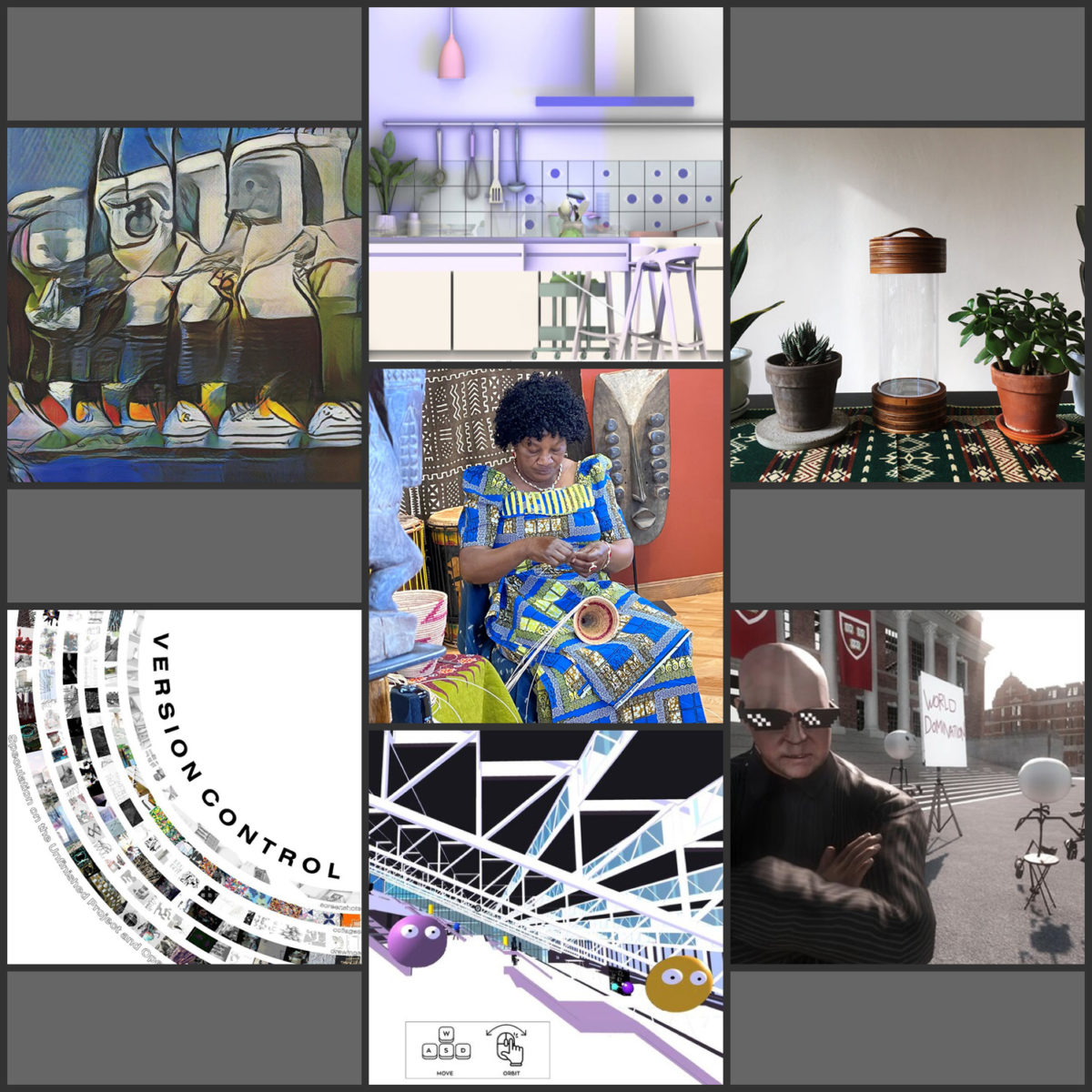
A collection of video works curated by the GSD Kirkland Gallery.
Commencement Simulator 2021
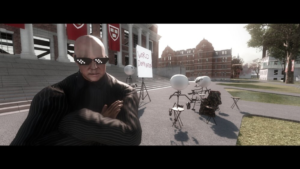
During the common academic life, memorable events happen all in one place. As a result, students, professors, staff, among many others, often learn to cherish its physical location. A building or a campus becomes one’s home, part of one’s day-to-day and coming-of-age. Yet, due to unfortunate events in the past year, these convivial places were made physically inaccessible.
The works presented in Clickbait utilizes the digital form to interpret iconic facilities, spaces, and events from Harvard University and the Graduate School of Design. The collective exhibit underscores the role of placemaking in academia. It highlights that even in challenging scenarios, there is a concern in reenvisioning common spaces and communities of the university. Although the physical site remains inaccessible, its ethos has not left our imagination. The works in Clickbait render visual and sensorial experiences that were not possible in the physical setting. They offer a participatory way to look back at familiar places while at the same time creatively speculating how they could be. By doing so, the participating artists and designers incorporated personal thoughts and artistic manifestations in its content and form. With these immersive works, iconic spaces of Harvard can be traversed again, but now they can also be clicked, viewed, liked, and shared.
Commencement Simulator 2021 intends to provide an online platform for an informal virtual commencement game for the class of 2021. The intent is to allow GSD students could come together in this virtual campus simulation to celebrate virtual commencement in a light-hearted and fun manner. The project also seeks to explore alternate forms of social assemblies, presentations, or even exhibitions during the pandemic lockdown. It seeks to challenge traditional notions of assembly, methods of narration, activist curation, and history archiving through virtualized narrations and interactions. Video games are a special digital art form that engages the audience actively in the production of its spatial-visual experiences. It is one of the few modes of narration where the continuation of the medium is dependent on the input of the user.
Producer: Mike Kwok (MDes HPDM 2021)
Curators: Hermano Luz Rodrigues (MDes ADPD 2021), Birdia Zuo (MDes ADPD 2021), Stephanie Lee Yeung (MDes ADPD 2021), Shiyu Liu (MDes ADPD 2022), Shane Ah-Siong (MDes ADPD 2022)
Video Duration: 3 min, 2 sec
Dear Grandmother,
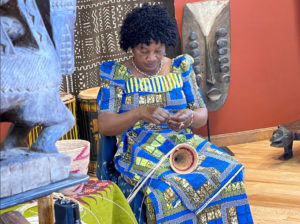
Dear Grandmother, is a 10-month digital storytelling project for Rwandan Refugee youth in Worcester, Massachusetts.
The project features the voice of Saidati, a high school refugee student, and her grandmother, an African Agaseke (basket)-making master, Patricia, who had experienced three genocides in Rwanda before coming to the U.S. in 2009.
The project aims to weave together several creative themes: introducing African refugee arts, accelerating intergenerational communication, and enhancing refugee-non refugee connection.
Biweekly sessions are designed as a hands-on learning experience. The sessions consist of mainly two parts; narrative design and video production. With the emphasis on the importance of the learning process, the project aims to produce the video as a final outcome of the 10-month journey.
This innovative community design methodology brings together traditional craft making with recorded video to share publicly through open spaces in Worcester, Saidati’s high school Department of Literature, and the websites of the collaborator organizations as well.
Ayaka, a graduate student at Harvard Graduate School of Design (GSD) and GSD Community Service Fellow of Summer 2020, initiated the project with guidance from the Refugee Artisans of Worcester and collaboration with Crocodile River Music in August 2020.
The City of Worcester has served as one of the top destinations for refugee resettlement and is known for creative art programs, which had been negatively impacted through COVID-19. The interview with the Worcester Cultural Coalition Director regarding the city’s response to COVID-19 inspired Ayaka to kickstart the program to pursue digital engagement of refugees which emphasizes the voice of refugee youth and prevents social isolation of the refugee artisans in this hard time.
The grandmother and granddaughter featured in the project represent a possible future series of videos highlighting the creative talent that contributes to resettled art diversity. Strong resourceful women contribute to the resiliency of not only their families but the intercultural community, as in this project.
Producers: Ayaka Yamashita (MDes RR 2021), Patricia Kayobera, Nisa Saidati Nisubreko
Curators: Hermano Luz Rodrigues (MDes ADPD 2021), Birdia Zuo (MDes ADPD 2021), Stephanie Lee Yeung (MDes ADPD 2021), Shiyu Liu (MDes ADPD 2022), Shane Ah-Siong (MDes ADPD 2022)
Directed by: Ayaka Yamashita
Director of Photography: Cyrille Vincent
Production Assistant: Jimmy Jackson
Video edited by: Solidarty
Story Editors: Ellen Ferrante, Joan Kariko
Music: Thierno Camara, Zach Combs
Research Consultant: Marino Fernandes, Ph.D.
Website & Storyboard Design: Ayaka Yamashita
Co-produced by: Crocodile River Music and Refugee Artisans of Worcester
Video Duration: 6 min, 29 sec
Fluid Expressions
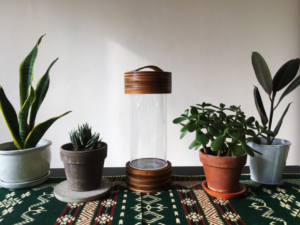
Fluid Expressions incorporates science, art, and design into an exploration of art-making and place-making in outer space. The exhibition takes the form of a work of online speculative fiction centered around the design and craft of an object called a memory capsule.
The exhibition describes the journey of a painter as they prepare to travel to low Earth orbit as Earth’s first space-artist-in-residence. Their goal is to capture the experience of microgravity as they free-fall toward and around Earth at nearly 5 miles a second. They are allowed a limited set of tools to carry with them to space, including a memory capsule that will act as canvas, easel, and containment for the occasion. They have crafted this object themselves from materials intended for use in space, but that also reminds them of their ties to Earth and to home. The narrative catalogs the journey they have taken, with asides on the unintuitive nature of movement and perception in microgravity and the design process of the memory capsule woven throughout.
This exhibition aims to explore the relationship between place and the art we create, how we see our homes from afar, and what inspires us about journeying into new regions that challenge and evolve our perceptions. However, the speculative nature of this work is grounded in real obstacles and opportunities afforded by travel off-planet, offering a hypothetical near-term future in which artists are among those who travel to and record our experiences of outer space.
This work was made possible by the MIT Space Exploration Initiative. Through their support, this project is scheduled to fly on a parabolic flight in May 2021, in order to perform with the memory capsule during periods of weightlessness. This zero-g performance provides an invaluable opportunity to bridge the gap between speculative design and its intended environment, allowing for future iteration and development of this work.
Producer: Sana Sharma (MDes Tech 2021)
Curators: Hermano Luz Rodrigues (MDes ADPD 2021), Birdia Zuo (MDes ADPD 2021), Stephanie Lee Yeung (MDes ADPD 2021), Shiyu Liu (MDes ADPD 2022), Shane Ah-Siong (MDes ADPD 2022)
Video Duration: 4 min, 40 sec
GSD Hallucinations
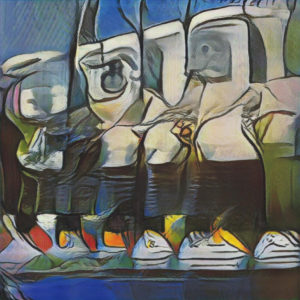
GSD Hallucinations questions what is the Gund Hall and what is physical. After more than a year since Gund hall closed, this exhibition explores this distant memory for some and imaginary figure for many. The concrete walls, stepped trays and deep blue glazed facades have become mental constructs carved by old images, Instagram posts, and Sarah Whiting’s nostalgic Zoom backgrounds.
As many students have left Cambridge, Gund Hall remains in their minds as individual fragments. The way in which each of us uses memory to abstract Gund Hall is a similar process to Generative Adversarial Networks. This project begins with the collection of over 1000 memories scattered in latent space as 512-dimensional vectors. Two trained GAN models, including the style transfer into the cubist eyes of Pablo Picasso help visualize this latent space, representing our distorted collective memory of this past year.
Producers: George Guida (MArch II 2022), Dongyun Kim (MDes Tech 2022)
Curators: Hermano Luz Rodrigues (MDes ADPD 2021), Birdia Zuo (MDes ADPD 2021), Stephanie Lee Yeung (MDes ADPD 2021), Shiyu Liu (MDes ADPD 2022), Shane Ah-Siong (MDes ADPD 2022)
Video Duration: 1 min, 52 sec
Gund.IO
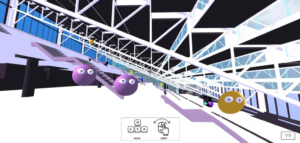
During the common academic life, memorable events happen all in one place. As a result, students, professors, staff, among many others, often learn to cherish its physical location. A building or a campus becomes one’s home, part of one’s day-to-day and coming-of-age. Yet, due to unfortunate events in the past year, these convivial places were made physically inaccessible.
The works presented in Clickbait utilizes the digital form to interpret iconic facilities, spaces, and events from Harvard University and the Graduate School of Design. The collective exhibit underscores the role of placemaking in academia. It highlights that even in challenging scenarios, there is a concern in reenvisioning common spaces and communities of the university. Although the physical site remains inaccessible, its ethos has not left our imagination. The works in Clickbait render visual and sensorial experiences that were not possible in the physical setting. They offer a participatory way to look back at familiar places while at the same time creatively speculating how they could be. By doing so, the participating artists and designers incorporated personal thoughts and artistic manifestations in its content and form. With these immersive works, iconic spaces of Harvard can be traversed again, but now they can also be clicked, viewed, liked, and shared.
Gund.io is an ongoing prototype of an immersive 3D environment for students and professors to virtually learn, collaborate, and socialize under one centralized platform. Through the digitization of our familiar, yet for many unfamiliar Gund Hall, we augmented this space through a gamification strategy and WebXR technologies. Users can navigate within this dynamic and multi-sensorial space with avatars and view the other exhibitions.
Producers: George Guida (MArch II 2022), Runjia Tian (MDes Tech 2021) , Yuebin Dong (MAUD, MDes 2021), Gabriella Perry (MDes Tech 2022)
Curators: Hermano Luz Rodrigues (MDes ADPD 2021), Birdia Zuo (MDes ADPD 2021), Stephanie Lee Yeung (MDes ADPD 2021), Shiyu Liu (MDes ADPD 2022), Shane Ah-Siong (MDes ADPD 2022)
Video Duration: 2 min, 29 sec
One X-Smart Kitchen: A Smart Home Narrative
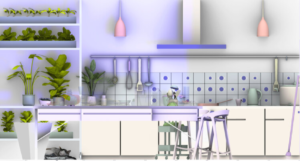
In its 2013 report, the McKinsey Global Institute identifies the Internet of things (IoT) as one of 12 technologies that have massive potential to drive economic impact and disruption by 2025. (Manyika et al., 2013). Home today comprised of all sorts of digitally-enabled networked objects. As more and more inanimate objects join the troop there is a network established among them that integrates each individual into a larger society of their own. This project explores the near-future scenarios of smart home objects, asking:
- In the same way that a group of human beings is connected together with shared values, goals, and interests is usually called a community, are things able to form communities by connecting to each other for specific purposes?
- What would the scenarios be when things can possibly go wrong with such prevalence of intelligent objects flooding our homes and the intensity of data collection?
- How might the form and experience of our domestic space change as we become used to live with these intelligent beings that take up our physical, virtual, and even emotional space?
Using the kitchen as a sample of the domestic space, this project imagines a playful future when casual technology and tangible forms of media equip all of our homes and the status of networked objects has evolved from the Internet of Things (IoT) to the Society of Things (SoT). Narrated from a first-person perspective, in a scenario where the human owner is using the online portal of their smart kitchen provider, the project shows how the human owner sees, through a webcam, that these animated, augmented, empathetic or smart objects use their intelligence to connect with one another and lead double lives with and without human presence.
Producer: Tiange Wang (MArch I 2022)
Curators: Hermano Luz Rodrigues (MDes ADPD 2021), Birdia Zuo (MDes ADPD 2021), Stephanie Lee Yeung (MDes ADPD 2021), Shiyu Liu (MDes ADPD 2022), Shane Ah-Siong (MDes ADPD 2022)
Video Duration: 1 min, 20 sec
Version Control
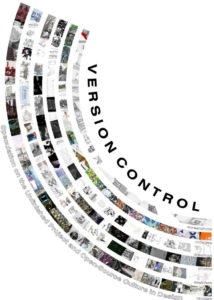
Version Control aims to build a collective and participatory experience amid Covid-19 as a response to the issues presented by the transition to the virtual classroom. In design, virtual studios lacked casual collaboration and off-hand comments that being in the same creative space tends to initiate. In a studio environment, when you get stuck on a design problem, you ask a friend for their opinion, or sometimes, a stranger offers an unsolicited view as they pass your desk. These kinds of interactions can change the trajectory of one’s design process. What if there was a place you could upload your unfinished work or abandoned concepts to receive feedback or criticism from both friends and strangers? What if people could build from each other’s ideas, and the different branches of thought were tracked and archived by the platform? What if designers embraced open-source culture as a way to develop ideas and embrace collaborative thinking more quickly? Version Control was conceived as a speculative solution to virtually emulating the complexities of thought circulation in a physical studio environment.
Version Control unveils the behind-scene process of creativity and de-glorifies the “design genius” under the star effect. When Covid-19 exacerbates the design workflow, those unpolished visual and ideological products speak for our internal struggles and become humanistic within the design discipline by different mediums that are not exclusively traditional to architecture.
The exhibition features an exclusive video that communicates and represents Version Control‘s recent outcomes. In a unique visual format, the commissioned video narrates the archive of the work collected in 2020 as a response to the project’s proposal. In addition to the archive of works, the creators of Version Control identified trends among the works and ties it back into architectural history and design pedagogy, particularly looking at the history of “unfinishedness” in architecture and the history of open-source culture in other fields.
Producers: Emily Majors (MArch I 2023), Davide Zhang (MArch I 2023)
Curators: Hermano Luz Rodrigues (MDes ADPD 2021), Birdia Zuo (MDes ADPD 2021), Stephanie Lee Yeung (MDes ADPD 2021)
Contributors: Alejandra Valdovinos, Austin Madrigale, Gabe Colombo, Clara He, Rebecca Romero, Hans Steffes, Elsa Hoover, Jeannelle Fernandez, Ben Schoenekase, Ben Creech, Aaron Sheffield, Nolan Summerhill, Pietro Mendonca, Paul McCoy, Alexandra Sanyal, Seb Fathi, Collin Stone, Eric Anderson, Veronica Rosado Perez, Thomas Huang, John Sarkis, Ayman Mortada, Phoebe Rhinehart, Yiou Wang, Signe Ferguson, Jonah Bobo, & Jack Wathieu
Special Thanks: Alejandra Valdovinos & Signe Ferguson
Video Duration: 26 min, 40 sec
During the COVID-19 pandemic, the galleries in Gund Hall have been turned ‘inside out,’ with exhibitions shown through a series of exterior projections on the building’s facade.